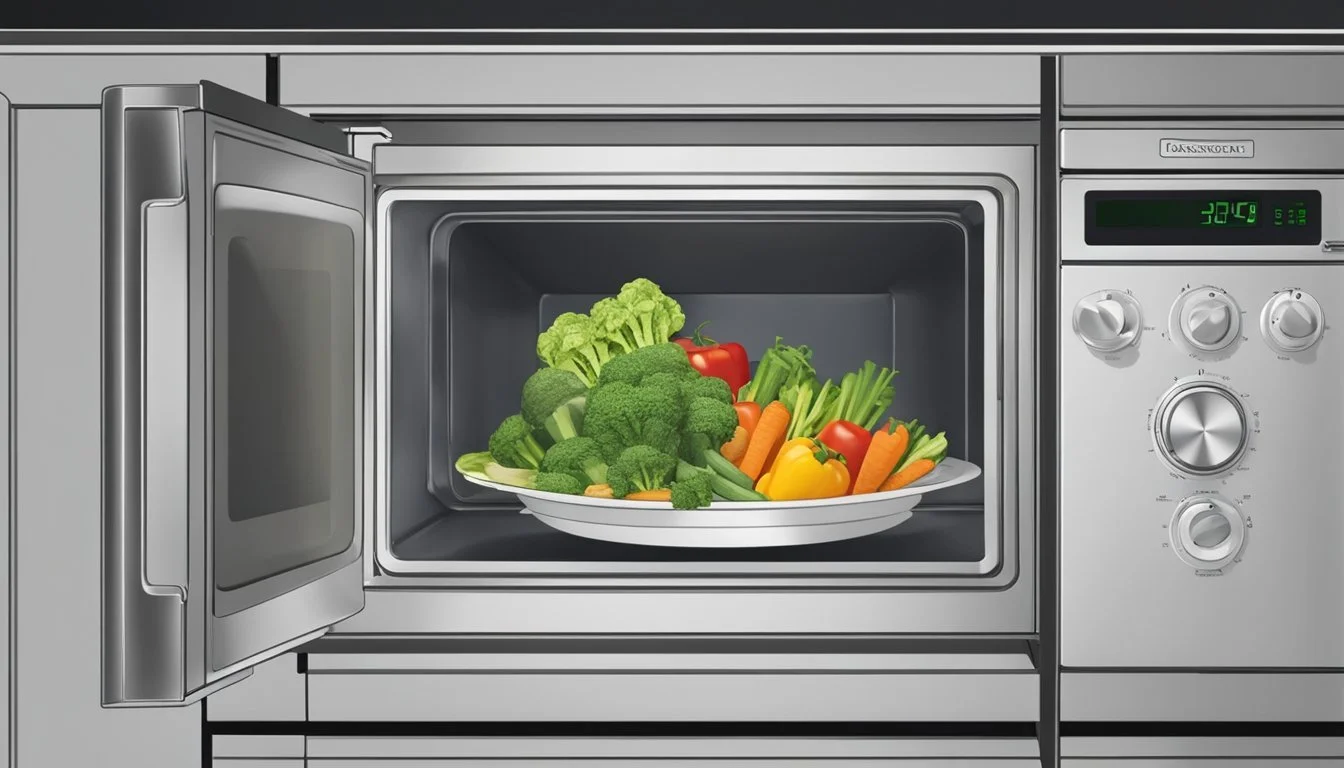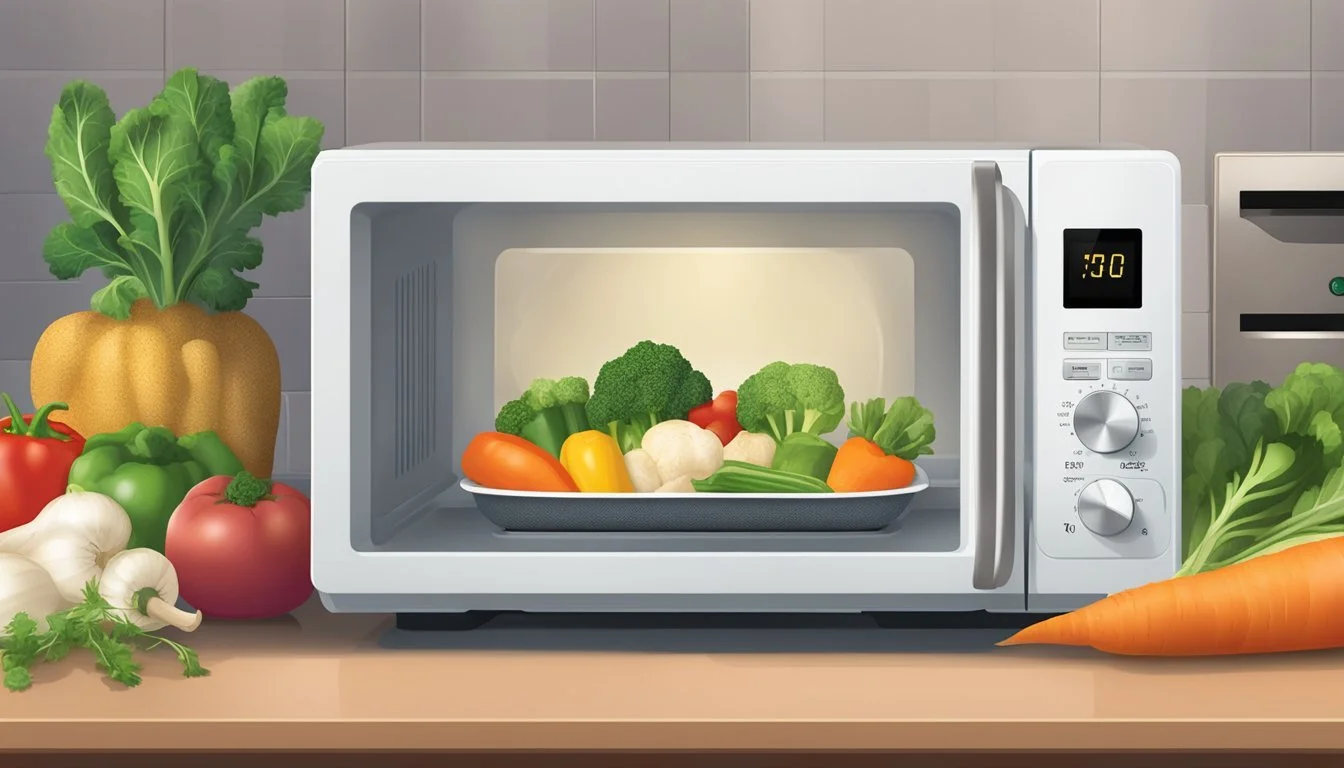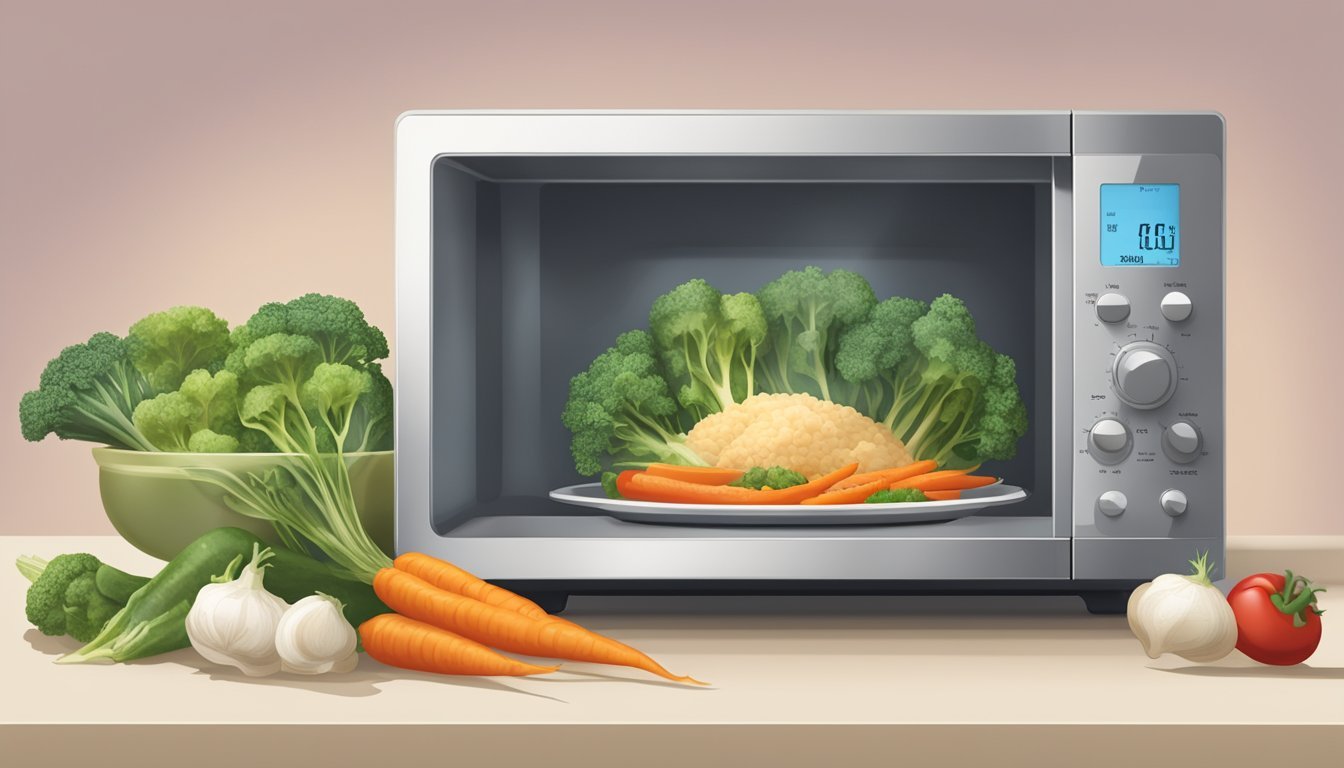How to Reheat Earthbound Farm Organic Mixed Vegetables
A Simple Guide
Reheating Earthbound Farm Organic Mixed Vegetables is a simple process that ensures you can enjoy your leftover vegetables without compromising on texture or flavor. These organic vegetables provide a nutritious and convenient way to incorporate more greens into your meals. To maintain the quality of your leftovers, cover the baking sheet with aluminum foil to trap heat and moisture, and reheat in a preheated oven for about 10-15 minutes.
The key to a successful reheating process is preventing the vegetables from drying out. Using a loose tent of aluminum foil helps to retain moisture, resulting in vegetables that are just as delicious as when they were first cooked. With this method, your Earthbound Farm Organic Mixed Vegetables will retain their vibrant flavors and beneficial nutrients.
By following these steps, you can ensure that even leftover vegetables from a previous meal remain a delightful part of your diet. This technique is particularly useful for those who often have leftover vegetables and want to make the most out of their organic produce without compromising on taste or nutrition.
Methods of Reheating Mixed Vegetables
The best methods for reheating Earthbound Farm Organic Mixed Vegetables include using an oven, stove, microwave, or air fryer. Each method has its advantages depending on the texture and temperature you want to achieve.
Reheating in the Oven
Reheating mixed vegetables in the oven helps retain their crispness and flavor. Preheat the oven to 400ºF (200ºC). Spread the vegetables evenly on a baking sheet. If they seem dry, drizzle a small amount of olive oil. Cover the baking sheet with aluminum foil to trap heat and maintain moisture. Place the tray in the oven for 10-15 minutes, shaking the tray halfway through to ensure even heating. Keep an eye on the texture and check occasionally to avoid overcooking.
Reheating on the Stove
Reheating on the stove gives precise control over texture and temperature. Use a non-stick skillet and add a small amount of olive oil or butter over medium heat. Spread the vegetables evenly in the skillet. Stir occasionally to prevent sticking and ensure even heating. This method takes about 5-7 minutes, depending on the quantity and thickness of the vegetables. Avoid using high heat to prevent the vegetables from becoming mushy.
Reheating in the Microwave
Using a microwave is the quickest method. Place the mixed vegetables in a microwave-safe dish. Cover the dish with a microwave-safe lid or a damp paper towel to trap steam and retain moisture. Heat on high for 2-3 minutes, stirring halfway through. Check the temperature and continue heating in 30-second intervals if needed. Be cautious with microwave reheating, as vegetables can become soggy if overcooked.
Reheating with an Air Fryer
An air fryer can reheat mixed vegetables while maintaining a crispy texture. Preheat the air fryer to 350ºF (175ºC). Spread the vegetables in a single layer in the air fryer basket. Cook for 4-5 minutes, shaking the basket halfway through the cooking time to ensure even heating. This method is ideal for maintaining a crunchy texture but requires a bit more attention to avoid overheating.
Preparing Vegetables for Reheating
Properly preparing Earthbound Farm Organic Mixed Vegetables for reheating ensures they retain their flavor and texture. Key steps include thawing frozen vegetables and enhancing them with appropriate seasonings and oils.
Thawing Frozen Vegetables
Thawing frozen vegetables before reheating allows for even cooking. It is recommended to remove the vegetables from the freezer and let them sit at room temperature for around 30 minutes. For a quicker option, place them in the refrigerator overnight.
Spread the vegetables in a single layer on a baking sheet for consistent thawing. Avoid stacking or crowding them. If you're in a hurry, using a microwave on a defrost setting can be a last resort, but be cautious of not overdoing as it might affect texture.
Adding Seasonings and Oils
Enhancing the flavor of reheated vegetables involves adding seasonings and oils. Drizzle olive oil over the vegetables to prevent them from drying out while reheating.
Sprinkle salt, pepper, and garlic powder evenly for a basic but flavorful profile. Fresh herbs like rosemary, thyme, or parsley can elevate the taste. Toss the vegetables well to ensure an even coating. If preferred, a dash of balsamic vinegar or a squeeze of lemon juice can be added for an extra punch.
Careful seasoning not only brings out the natural flavors but also rejuvenates any leftovers, making them more enjoyable.
Safety and Storage Tips
Proper storage is critical in maintaining the freshness and safety of cooked Earthbound Farm organic mixed vegetables. Ensuring they are stored correctly prevents bacteria growth and food waste. Identifying spoilage signs early can help avoid consuming bad food.
Storing Cooked Vegetables
Store cooked vegetables in an airtight container. This helps keep them fresh and prevents bacteria and mold growth.
Place the container in the fridge within two hours of cooking to keep them safe from harmful bacteria.
Make sure the refrigerator is set to 40°F (4°C) or lower.
Properly stored, cooked vegetables can last in the fridge for 3-5 days. Always reheat leftovers to an internal temperature of 165°F (74°C) before eating to ensure safety.
Identifying Spoilage
Check for changes in color and texture as signs of spoilage. Vegetables that look discolored or mushy should not be eaten.
Smell is also a strong indicator; if the vegetables emit a sour or off-putting odor, it’s best to discard them.
The presence of mold is a clear sign that the veggies have gone bad and should be thrown out immediately. Be vigilant about these signs to ensure that the food consumed is fresh and safe.
Staying alert and following these tips can prevent foodborne illnesses and reduce food waste effectively.
Enhancing Flavor and Nutritional Value
When reheating Earthbound Farm Organic Mixed Vegetables, focusing on both flavor enhancement and nutrient retention is key. Using fresh herbs and precise reheating techniques can significantly improve the taste while retaining essential nutrients.
Choosing the Right Seasonings
Selecting appropriate seasonings can dramatically boost the flavor of reheated mixed vegetables. Fresh herbs, such as basil, parsley, and cilantro, add vibrant flavors. Sprinkling lemon zest or lime juice can introduce a refreshing zesty taste.
Garlic and onion powder are excellent for depth, while a light drizzle of olive oil or melted butter can enhance richness. For an extra flavor kick, consider a touch of low-sodium soy sauce or a sprinkle of smoked paprika. These seasonings can bring roasted flavors and complexity to carrots, broccoli, cauliflower, and spinach.
Retaining Nutrients During Reheating
Proper reheating methods are crucial to maintaining the nutritional value of mixed vegetables. Steaming is an excellent option, as it uses minimal water and helps preserve vitamins such as Vitamin C and folate. Microwave steaming in a covered dish with a small amount of water can also be effective and quick.
Using lower heat settings and shorter durations reduces nutrient loss. When using the oven, cover vegetables with foil to trap moisture and prevent oxidation. Avoid boiling, as it can lead to significant nutrient depletion by leaching vitamins and minerals into the water. These methods ensure that vegetables retain maximum nutritional benefits while achieving optimal flavor.
Troubleshooting Common Issues
Reheating Earthbound Farm Organic Mixed Vegetables can sometimes result in undesired textures or uneven heating. Here are specific strategies for preventing soggy or overcooked vegetables and ensuring even heating every time.
Preventing Soggy or Overcooked Vegetables
Mushy or overcooked vegetables can be a common problem. To retain the vegetables' texture and avoid overcooking, it's essential to monitor the oven temperature closely. Setting the oven to 350°F usually works well.
Use parchment paper or foil to cover the vegetables. This helps retain moisture without making them too soggy. Spread them in a single layer on a baking sheet for the best results. Be sure not to pile them up, as this can cause uneven cooking.
If you notice the vegetables turning mushy, try reducing the reheating time. Checking them with a fork halfway through can help assess their doneness. This allows you to adjust the time accordingly to avoid overcooking.
Achieving Even Heating
Achieving even heating is crucial for maintaining flavor and texture. Spread the vegetables out evenly on the baking sheet. Overcrowding can lead to some parts being overcooked while others remain cold.
Turning the vegetables midway through the reheating process helps ensure even distribution of heat. Use a fork or spatula to gently stir them.
Covering them with foil can also aid in balanced heating by preventing the edges from overcooking while the center warms up. Consider using an oven thermometer to confirm that the reheating temperature stays consistent throughout the process.
Adjusting these methods helps maintain the crispiness and nutritional value of the Earthbound Farm Organic Mixed Vegetables, providing the best reheated experience.
Special Techniques for Specific Vegetables
Different vegetables require specific techniques to ensure they maintain their flavor and texture during reheating. For instance, delicate vegetables need minimal heat to avoid wilting, while denser vegetables require thorough warming to achieve an even temperature throughout.
Reheating Delicate Vegetables Like Spinach
Delicate vegetables, such as spinach and zucchini, are prone to becoming soggy if overheated. When reheating spinach, use the stovetop method:
Heat a Non-Stick Pan: Lightly coat a pan with olive oil or butter.
Add Spinach: Place spinach in the pan over medium-low heat.
Stir Gently: Stir continuously for 1-2 minutes until warmed through.
For microwaving, place spinach in a microwave-safe dish, cover with a damp paper towel, and heat on low for 20-30 seconds. This prevents drying out and ensures even warmth.
Reheating Denser Vegetables Like Potatoes
Denser vegetables like potatoes, broccoli, and cauliflower need a different approach to preserve their firm texture. Oven reheating is ideal:
Preheat Oven to 350°F: Use an even, moderate temperature.
Prepare Baking Sheet: Arrange vegetables in a single layer on a baking sheet.
Reheat for 15-20 Minutes: Check every 10 minutes and flip to ensure even heating.
For potatoes, cut into smaller pieces to speed up the reheating process. Covering with foil can trap moisture, preventing dryness. If using a microwave, place in a microwave-safe bowl, cover with a damp cloth, and heat on medium power in 1-minute increments. Stir between intervals for uniform reheating.
Optimizing Reheating Times and Temperatures
When reheating Earthbound Farm Organic Mixed Vegetables, selecting the right temperatures and cooking times is essential.
Oven Method
Preheat the oven to 375°F. Place the vegetables on a baking sheet in a single layer to ensure even heating. Cover the baking sheet with aluminum foil to trap moisture and heat.
Set a timer for 10-15 minutes. Check frequently to avoid overcooking.
Microwave Method
Use a microwave-safe dish. Arrange the vegetables evenly, preferably in a single layer.
Set the microwave to medium-high heat (70-80%). Heat for 2-3 minutes, stirring halfway through to ensure even warming. Adjust time based on the quantity.
Sauté Method
For a quick option, use a skillet. Heat the skillet to medium heat.
Add a small amount of oil if needed. Sauté the vegetables for 3-5 minutes while stirring occasionally. This method retains crispness and moisture.
Using these methods ensures that the vegetables are evenly reheated and retain their texture and flavor.
Incorporating Leftovers Into New Meals
Leftover Earthbound Farm Organic Mixed Vegetables can be transformed into a variety of delicious and nutritious new meals, making meal prep easier and more sustainable. Utilizing leftovers can help maintain a balanced diet while reducing waste and saving time.
Creative Recipes with Reheated Vegetables
Stirred into Soup: Add reheated mixed vegetables into a homemade soup for extra heartiness. The vegetables can be blended into a creamy soup or left whole for a chunkier texture. This not only enriches the flavor but also boosts the nutritional value of the soup without adding many extra calories.
Mixed with Mac and Cheese: Integrate reheated mixed vegetables into mac and cheese for a nutritious twist. The vegetables add texture and essential nutrients, turning a simple comfort food into a more balanced meal. It's a great way to increase fiber intake for both adults and children.
Used in Meal Prep Containers: Incorporate the reheated mixed vegetables into meal prep containers for an easily accessible, balanced diet. Pair these with proteins like chicken or tofu and grains such as quinoa or brown rice. This approach ensures that you have meals ready throughout the week, simplifying your meal planning process.
Preventing Food Waste and Maximizing Shelf Life
Proper storage can significantly reduce food waste and extend the shelf life of Earthbound Farm Organic Mixed Vegetables.
Storage Tips:
Always store fresh vegetables in the crisper drawer of the refrigerator. This helps maintain optimal humidity levels.
Separate ethylene-producing vegetables (e.g., apples, peaches) from others to avoid premature ripening.
Freezer Guidelines:
Vegetables can be frozen to maximize their shelf life. Use an airtight policy for storing vegetables in the freezer to prevent freezer burn. Ensure they are completely cooled before freezing. Utilize zip-lock bags or storage containers that are airtight.
Labeling and Rotation:
Clear labels on leftover vegetables will help track usage. Write the date of storage to prioritize items nearing the end of their shelf life. Rotate older items to the front of the fridge or freezer to ensure they are used first.
Transform leftover vegetables into new meals. Add them to soups, casseroles, or salads. This not only prevents waste but also adds nutritional variety to your meals.
Weekly Plans:
Create a weekly meal plan. Consider portions to avoid over-preparing food, reducing the chance of leftovers that might go uneaten. Planning helps in buying only what is needed, leading to less waste.
By following these simple tips, extending the shelf life of mixed vegetables and minimizing food waste becomes achievable.











